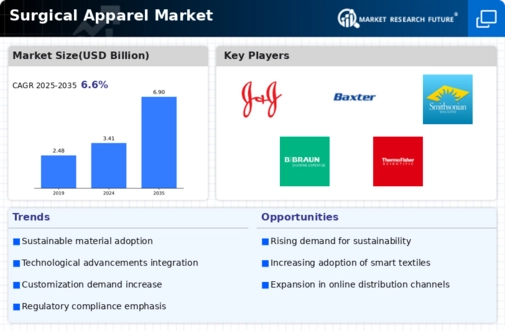Surgical Apparel Size
Surgical Apparel Market Growth Projections and Opportunities
The Surgical Apparel Market is influenced by a multitude of market factors that collectively shape its dynamics and growth trajectory. One of the primary drivers is the rising global healthcare expenditure. As nations allocate substantial budgets towards healthcare infrastructure development, including hospitals and clinics, the demand for surgical apparel experiences a parallel surge. The increasing prevalence of chronic diseases and a growing aging population further amplify the need for surgical procedures, subsequently boosting the market for surgical apparel.
Technological advancements play a pivotal role in shaping the Surgical Apparel Market. The continuous evolution of materials and manufacturing processes results in the production of high-performance, comfortable, and cost-effective surgical attire. Innovations such as antimicrobial fabrics and disposable surgical gowns enhance infection control measures, contributing to the market's expansion. As healthcare providers prioritize patient safety and infection prevention, the adoption of advanced surgical apparel becomes imperative, driving market growth.
Government regulations and standards also significantly impact the Surgical Apparel Market. Stringent guidelines related to hygiene, safety, and quality control drive manufacturers to adhere to specific norms, ensuring the production of reliable and compliant surgical attire. Regulatory bodies play a crucial role in establishing and maintaining industry standards, creating a foundation of trust for both healthcare professionals and patients. Compliance with these regulations becomes a key factor in determining market success and longevity.
Globalization and trade patterns contribute to the complexity of the Surgical Apparel Market. International trade agreements, economic conditions, and geopolitical factors influence the procurement and distribution of surgical apparel across borders. Additionally, the interconnectedness of economies results in the transfer of technological know-how and best practices, fostering a global market where manufacturers and suppliers collaborate on a broader scale.
Consumer awareness and preferences also shape the dynamics of the Surgical Apparel Market. With an increasing focus on patient-centric care, there is a growing demand for comfortable, breathable, and aesthetically pleasing surgical attire. Healthcare professionals are becoming more discerning in their choices, leading manufacturers to invest in research and development to meet evolving preferences. As awareness about the importance of infection control rises, consumers are more likely to opt for high-quality surgical apparel, driving market growth.
Market competition is another crucial factor influencing the Surgical Apparel Market. The presence of numerous manufacturers and suppliers intensifies competition, prompting companies to differentiate themselves through product innovation, pricing strategies, and distribution networks. Market players continuously strive to gain a competitive edge by offering a diverse range of surgical apparel that meets the varying needs of healthcare facilities and professionals.
Lastly, the COVID-19 pandemic has brought unprecedented challenges and opportunities to the Surgical Apparel Market. The increased demand for personal protective equipment (PPE), including surgical apparel, in the wake of the pandemic has accelerated market growth. The pandemic has underscored the importance of robust supply chains, resilience, and adaptability within the industry.










Leave a Comment